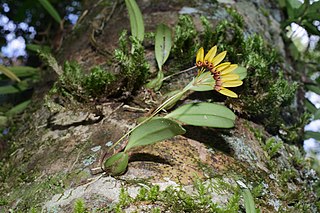| Image | Name | Distribution | Elevation (m) |
|---|
 | Bulbophyllum callichroma Schltr. 1913 | Indonesia and New Guinea | 600–2,200 metres (2,000–7,200 ft) |
| Bulbophyllum cardiophyllum J.J.Verm. 1991 | Papua New Guinea | 2,300 metres (7,500 ft) |
| Bulbophyllum cateorum J.J.Verm. 1992 | New Guinea | 1,700–2,500 metres (5,600–8,200 ft) |
| Bulbophyllum chloranthum Schltr. 1905 | Papua and New Guinea, Indonesia, and the Solomon Islands | 0–1,000 metres (0–3,281 ft) |
| Bulbophyllum dekockii J.J.Sm. 1911 | New Guinea | 2,900–3,300 metres (9,500–10,800 ft) |
| Bulbophyllum dendrochiloides Schltr. 1913 | New Guinea | 1,000 metres (3,300 ft) |
| Bulbophyllum fonsflorum J.J.Verm. 1990 | Papua New Guinea | 1,800–2,800 metres (5,900–9,200 ft) |
| Bulbophyllum graciliscapum Schlechter 1905 | New Guinea, Solomons, Vanuatu | 50–400 metres (160–1,310 ft) |
| Bulbophyllum grammopoma J.J.Verm. 1991 | New Guinea | 1,600–2,600 metres (5,200–8,500 ft) |
| Bulbophyllum hengstumianum J.J.Verm., de Vogel & A.Vogel 2010 | Bismarck Archipelago | 275 metres (902 ft) |
| Bulbophyllum kaniense Schltr. 1913 | New Guinea | 1,000 metres (3,300 ft) |
| Bulbophyllum levatii Kraenzl.1929 | New Guinea, Solomon and Vanuatu Islands | 1,000 metres (3,300 ft) |
| Bulbophyllum macrourum Schltr. 1905 | Papua New Guinea | 800–2,000 metres (2,600–6,600 ft) |
| Bulbophyllum mulderae J.J.Verm. 1993 | New Guinea | 1,500–2,000 metres (4,900–6,600 ft) |
| Bulbophyllum myon J.J.Verm. 1990 | Papua New Guinea | 1,800–3,000 metres (5,900–9,800 ft) |
| Bulbophyllum olivinum J.J.Sm. 1934 | New Guinea | 1,500–3,000 metres (4,900–9,800 ft) |
| Bulbophyllum orbiculare J.J.Sm. 1912 | Moluccas, New Guinea and the Solomon Islands | 650–2,500 metres (2,130–8,200 ft) |
| Bulbophyllum oreodoxa Schltr. 1913 | New Guinea | 450–1,500 metres (1,480–4,920 ft) |
| Bulbophyllum phormion J.J.Verm. 1992 | New Guinea | 2,200–3,200 metres (7,200–10,500 ft) |
| Bulbophyllum pidacanthum J.J.Verm. 1992 | New Guinea | 1,500–2,600 metres (4,900–8,500 ft) |
| Bulbophyllum sceliphron J.J.Verm. 1991 | Papua New Guinea | 2,000 metres (6,600 ft) |
| Bulbophyllum scopa J.J.Verm. 1990 | New Guinea | 1,200–2,000 metres (3,900–6,600 ft) |
| Bulbophyllum subpatulum J.J.Verm. 2002 | New Guinea | |
| Bulbophyllum trifilum J.J.Sm. 1908 | Moluccas and New Guinea | 300–2,400 metres (980–7,870 ft) |
|



















